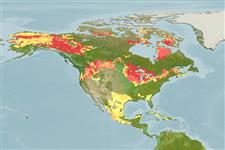Classification / Names
Common names from other countries
Main reference
Size / Weight / Age
Max length : 150 cm TL male/unsexed; (Ref. 40637); common length : 50.0 cm TL male/unsexed; (Ref. 6114); max. published weight: 32.7 kg (Ref. 40637); max. reported age: 50 years (Ref. 3494)
Length at first maturity
Lm ?, range 42 - 50 cm
Environment
Freshwater; benthopelagic; non-migratory; depth range 18 - 53 m (Ref. 1998), usually 18 - 53 m (Ref. 1998)
Climate / Range
Temperate, preferred ?; 65°N - 43°S
Distribution
North America: Widely distributed from northern Canada and Alaska south to New England in USA and Great Lakes basin in Canada-USA. Introduced widely to many areas outside its native range.
Splakes (hybrid between Salvelinus namaycush and Salvelinus fontinalis) have also been successfully introduced to many areas of North America. The three observed phenotypes existing in Lake Superior (lean, siscowet and humper or paperbelly) are under some genetic control and not merely expressions of environmental adaptation (Ref. 40529).
Countries | FAO areas | Ecosystems | Occurrences | Introductions
Short description
Dorsal
spines
(total): 4 - 5;
Dorsal
soft rays
(total): 8-10;
Anal
spines: 4-5;
Anal
soft rays: 8 - 10;
Vertebrae: 61 - 69. Distinguished by its color, white or yellowish spots on a dark green to grayish background, its deeply forked tail and its numerous pyloric caeca. Lateral line slightly curved anteriorly; pelvic fins with small axillary process (Ref. 27547). Body typically trout-like, elongate, somewhat rounded. Head stout, broad dorsally; mouth large, terminal, snout usually protruding slightly beyond lower jaw when mouth is closed. Back and sides usually dark green liberally sprinkled with whitish to yellowish (never pink or red) spots; overall color varies from light green to gray, brown, dark green or nearly black; belly white; pale spots present on dorsal, adipose and caudal fins and usually on base of anal; sometimes orange-red on paired fins, especially in northern populations; anterior edge of paired and anal fins sometimes with a white border. At spawning time, males develop a dark lateral stripe and become paler on the back (Ref. 27547). Caudal fin with 19 rays (Ref. 2196). Distinguished from congeners in Europe by the unique dark brown head, body, dorsal and caudal fins, covered by small pale spots; differs also by its deeply forked caudal fin (Ref. 59043).
IUCN Red List Status (Ref. 115185)
Threat to humans
Harmless
Human uses
Fisheries: commercial; aquaculture: commercial; gamefish: yes
Tools
Special reports
Download XML
Internet sources
Estimates of some properties based on models
Phylogenetic diversity index
PD50 = 0.5000 many relatives (e.g. carps) 0.5 - 2.0 few relatives (e.g. lungfishes)
Trophic Level
4.3 ±0.5 se; Based on diet studies.
Resilience
Low, minimum population doubling time 4.5 - 14 years (K=0.05-0.12; tm=5-20; tmax=50; Fec=5,000)
Vulnerability
High to very high vulnerability (72 of 100)
Price category
